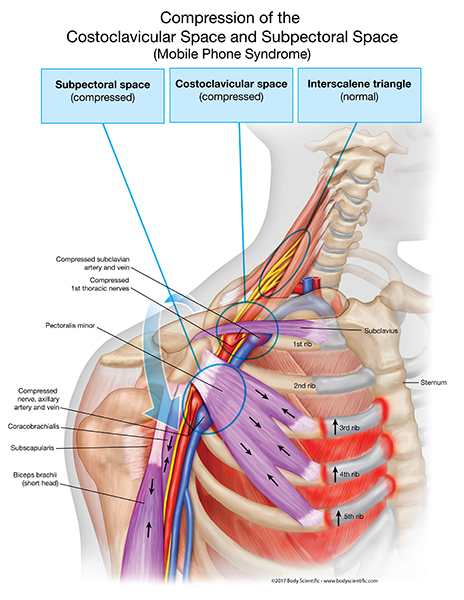

Stretch daily, and perform exercises that keep your shoulder muscles strong.ĭaily stretches focusing on the chest, neck and shoulders can help improve shoulder muscle strength and prevent thoracic outlet syndrome. If you're overweight, losing weight may help you prevent or relieve symptoms of thoracic outlet syndrome.Įven if you don't have symptoms of thoracic outlet syndrome, avoid carrying heavy bags over your shoulder, because this can increase pressure on the thoracic outlet. If you're at risk for thoracic outlet compression, avoid repetitive movements and lifting heavy objects. For neurogenic TOS, it is important to seek medical attention with appropriate evaluation and testing. For patients with venous or arterial TOS, it is important to seek urgent medical attention to make the correct diagnosis and implement appropriate treatment. Thoracic outlet syndrome may occur at any age but is most commonly diagnosed in adults between the ages of 20 and 50.Ĭomplications from this condition stem from the type of presentation (neurogenic, venous or arterial). Females are greater than three times more likely to be diagnosed with thoracic outlet syndrome than are males. There are several factors that seem to increase the risk of thoracic outlet syndrome, including: The onset of symptoms related to a traumatic accident often is delayed. A traumatic event, such as a car accident, can cause internal changes that then compress the nerves in the thoracic outlet. Drooping your shoulders or holding your head in a forward position can cause compression in the thoracic outlet area. Inherited defects that are present at birth (congenital) may include an extra rib located above the first rib (cervical rib) or an abnormally tight fibrous band connecting your spine to your rib. The cause of the compression varies and can include: Thoracic outlet syndrome is usually caused by compression of the nerves or blood vessels in the thoracic outlet, just under your collarbone (clavicle). See your doctor if you consistently experience any of the signs and symptoms of thoracic outlet syndrome. Lack of color (pallor) or bluish discoloration (cyanosis) in one or more of your fingers or your entire hand.Signs and symptoms of arterial thoracic outlet syndrome can include: Paleness or abnormal color in one or more fingers or your hand.

Blood clot in veins in the upper area of your body.Discoloration of your hand (bluish color).Signs and symptoms of venous thoracic outlet syndrome can include: Pain or aches in your neck, shoulder, arm or hand.Numbness or tingling in your arm or fingers.When nerves are compressed, signs and symptoms of neurogenic thoracic outlet syndrome include: Thoracic outlet syndrome symptoms can vary depending on the type. It's possible to have a mix of the three different types of thoracic outlet syndrome, with multiple parts of the thoracic outlet being compressed. It occurs when one of the arteries under the collarbone is compressed, resulting in bulging of the artery, also known as an aneurysm. This type of thoracic outlet syndrome occurs when one or more of the veins under the collarbone (clavicle) are compressed, resulting in blood clots. The brachial plexus is a network of nerves that come from your spinal cord and control muscle movements and sensation in your shoulder, arm and hand. This most common type of thoracic outlet syndrome is characterized by compression of the brachial plexus. Neurogenic (neurologic) thoracic outlet syndrome.

There are three general types of thoracic outlet syndrome:


 0 kommentar(er)
0 kommentar(er)
